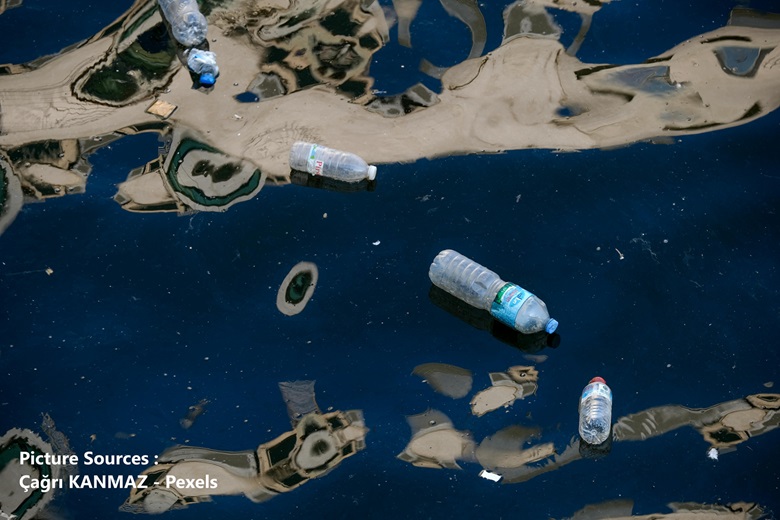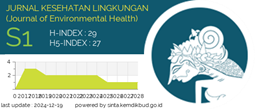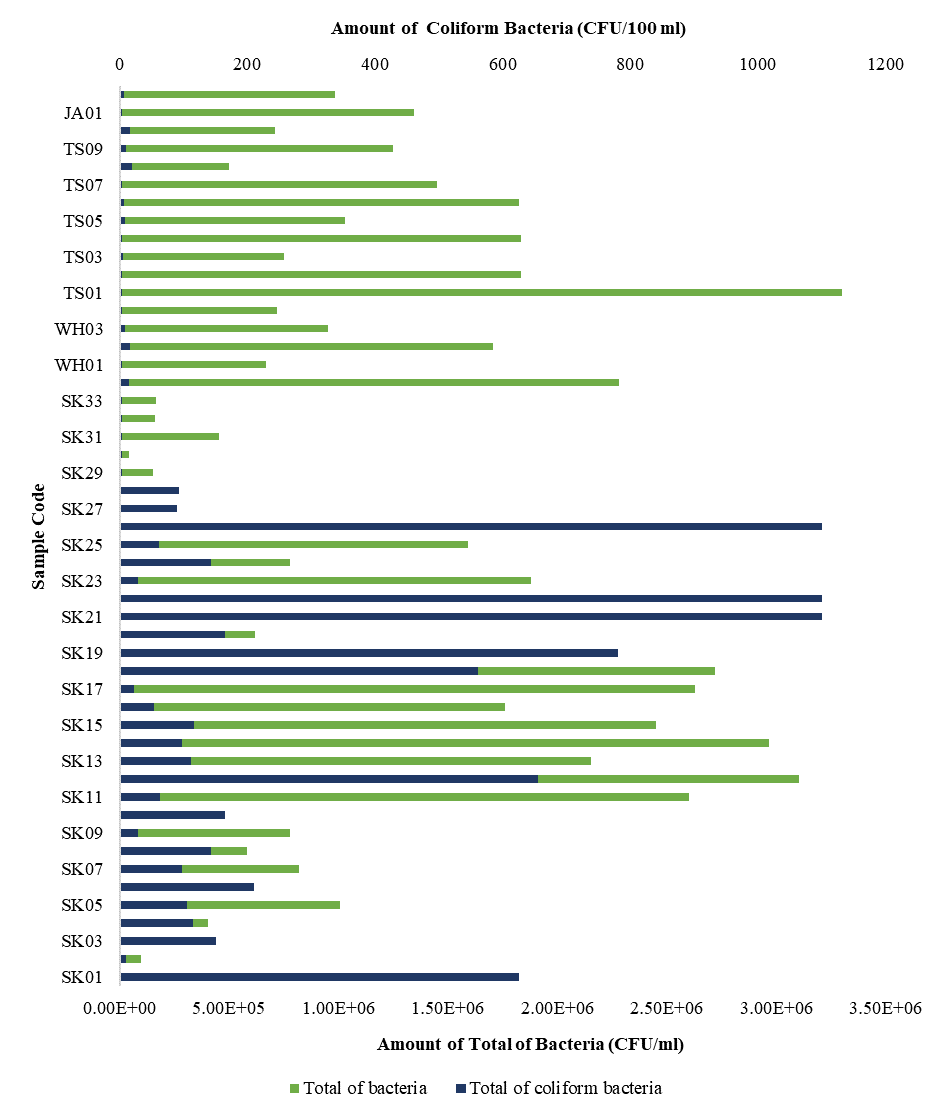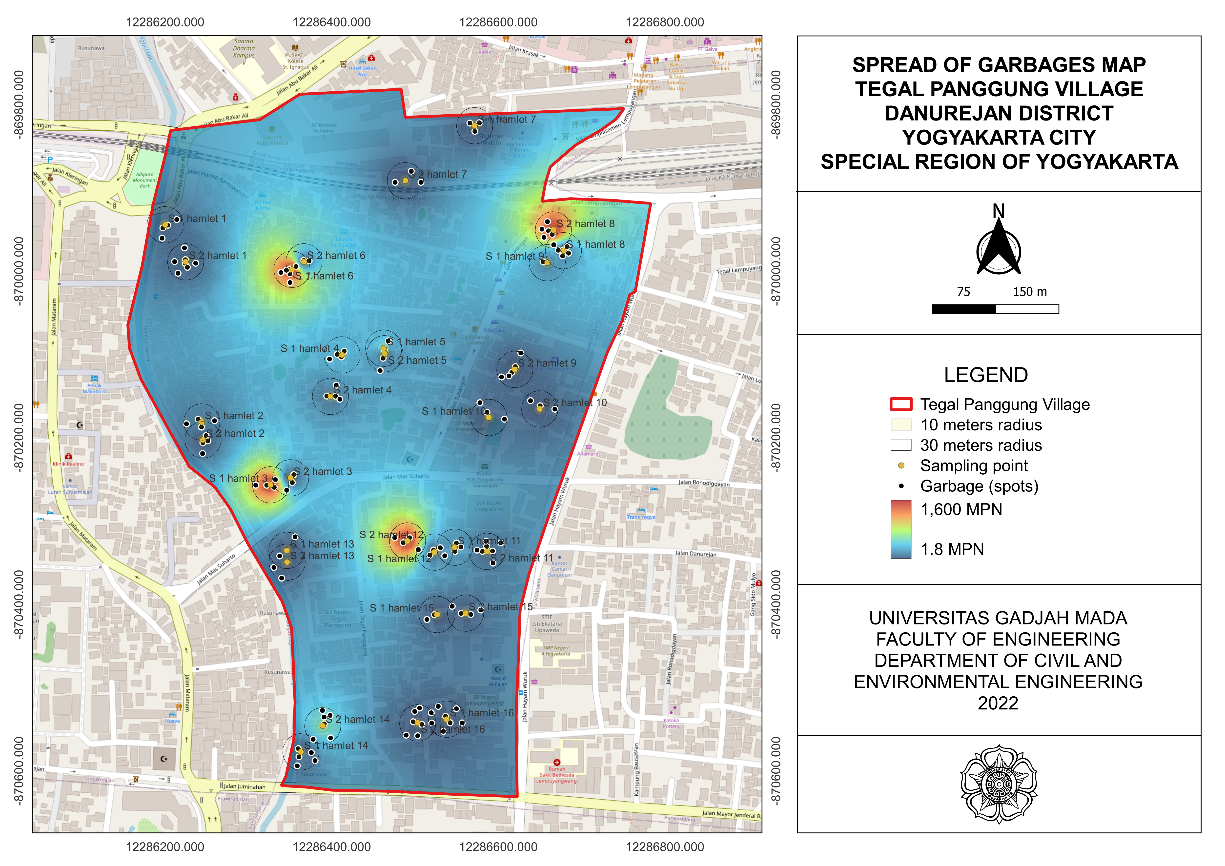Microplastic Contamination in Well Water in Coastal Area of Jember Regency: Study of Characteristics, Abundance and Potential Causal Factors

Introduction: Sand-textured soil such as coastal makes it easier for microplastics to migrate over longer distances. Kalimalang Hamlet, a coastal area, has a sandy soil texture and most of its people consume untreated dug well water. This condition if it occurs in the long term can cause health problems, such as oxidative stress, metabolic changes, immune dysfunction, and cancer. This study is aimed at analyzing the content, abundance, and causative factors of microplastics in the well water of the community of Kalimalang Hamlet. Methods: This study is a quantitative-research with a descriptive method. Thirty samples of people who consumed water were selected by accidental sampling. Ten wells location was determined using cluster random sampling followed by proportional random sampling. Data analysis used was univariate with crosstab. Results and Discussion: The results showed that 10 dug wells were polluted with microplastics with a total of 188 particles with a size of 0.13-7.24 mm and identified forms of fibers, fragments, filaments. It is estimated that there are 235 microplastic particles per day consumed by the community through dug well water. Well depth, floor, sewerage, and distance from the waste management site have the potential to increase the abundance of microplastics. Conclusion: The distance of the dug well from the sea was not a major factor. This shows the need to implement plastic waste management such as 3R, boiling, and multistage filtration in the dug well water that will be consumed.
Liu K, Wang X, Wei N, Song Z, Li D. Accurate Quantification and Transport Estimation of Suspended Atmospheric Microplastics in Megacities: Implications for Human Health. Environment International. 2019;132(1):1-10. https://doi.org/10.1016/j.envint.2019.105127
National Oceanic and Atmospheric Administration. Microplastics. United States: National Oceanic and Atmospheric Administration; 2023. https://marinedebris.noaa.gov/what-marine-debris/microplastics
Meijer LJJ, van Emmerik T, van der Ent R, Schmidt C, Lebreton L. More than 1000 Rivers Account for 80% of Global Riverine Plastic Emissions Into the Ocean. Science Advances. 2021;7(18):1–13. https://doi.org/10.5327/Z2176-94781900
The Ministry of Environment and Forestry of Republic Indonesia. Performance Report of 2022. Jakarta: The Ministry of Environment and Forestry of Republic Indonesia; 2023.
Gong X, Tian L, Wang P, Wang Z, Zeng L, Hu J. Microplastic Pollution in the Groundwater Under a Bedrock Island in the South China Sea. Environment Research. 2023;239(117277). https://doi.org/10.1016/j.envres.2023.117277
Du S, Zhu R, Cai Y, Xu N, Yap PS, Zhang Y, et al. Environmental Fate and Impacts of Microplastics in Aquatic Ecosystems: A Review. RSC Advances. 2021;11(26):15762–15784. https://doi.org/10.1039/D1RA00880C
Abdullah TO, Ali SS, Al-Ansari NA, Knutsson S, Laue J. Magnitude and Direction of Groundwater Seepage Velocity in Different Soil and Rock Materials. Engineering. 2020;12(04):242–253. https://doi.org/10.4236/eng.2020.124020
Goeppert N, Goldscheider N. Experimental Field Evidence for Transport of Microplastic Tracers Over Large Distances in an Alluvial Aquifer. Journal of Hazardous Materials. 2020;408(1):1–32. https://doi.org/10.1016/j.jhazmat.2020.124844
Çobanoğlu H, Belivermiş M, Sıkdokur E, Kılıç Ö, Çayır A. Genotoxic and Cytotoxic Effects of Polyethylene Microplastics on Human Peripheral Blood Lymphocytes. Chemosphere. 2021;272(129805):1-6. https://doi.org/10.1016/j.chemosphere.2021.129805
Ariyunita S, Dhokhikah Y, Subchan W. The First Investigation of Microplastics Contamination in Estuarine Located in Puger District, Jember Regency, Indonesia. Jurnal Riset Biologi dan Aplikasinya. 2021;3(1):7–13. https://doi.org/10.26740/jrba.v3n1.p7-12
Bhuyan MS. Effects of Microplastics on Fish and in Human Health. Front in Environmental Science. 2022;10(2022):1–17. https://doi.org/10.3389/fenvs.2022.827289
Li Y, Tao L, Wang Q, Wang F, Li G, Song M. Potential Health Impact of Microplastics: A Review of Environmental Distribution, Human Exposure, and Toxic Effects. Environment and Health. 2023;1(4):249–257. https://doi.org/10.1021/envhealth.3c00052
Azizah P, Ridlo A, Suryono CA. Mikroplastik pada Sedimen di Pantai Kartini Kabupaten Jepara Jawa Tengah. Journal of Marine Research. 2020;9(3):326–332. https://doi.org/10.14710/jmr.v9i3.28197
Cha J, Lee JY, Chia RW. Microplastics Contamination and Characteristics of Agricultural Groundwater in Haean Basin of Korea. Science of the Total Environment. 2023;864(2023):1-11. https://doi.org/10.1016/j.scitotenv.2022.161027
Samandra S, Johnston JM, Jaeger JE, Symons B, Xie S, Currell M, et al. Microplastic Contamination of an Unconfined Groundwater Aquifer in Victoria, Australia. Science of the Total Environment. 2022;802(1):1-9. https://doi.org/10.1016/j.scitotenv.2021.149727
Chia RW, Lee JY, Kim H, Jang J. Microplastic Pollution in Soil and Groundwater: A Review. Environmental Chemistry Letters. 2021;19(6):4211–4224. https://doi.org/10.1007/s10311-021-01297-6
Argiandini DM. Identifikasi Kelimpahan Mikroplastik di Sekitar Perairan Provinsi Gorontalo. Environmental Pollution Journal. 2023;3(1):582–588. https://doi.org/10.58954/epj.v3i1.106
Wienardy AE, Fitriyah F, Syarifah U. Identifikasi Tipe dan Kelimpahan Mikroplastik pada Ikan Nila (Oreochromis niloticus) di Waduk Lahor Kabupaten Malang, Jawa Timur. Biology Natural Resources Journal. 2023;2(2):68–74. https://doi.org/10.55719/binar.v2i2.693
Fachrul MF, Rinanti A, Tazkiaturrizki T, Agustria A, Naswadi DA. Degradasi Mikroplastik pada Ekosistim Perairan oleh Bakteri Kultur Campuran Clostridium sp. dan Thiobacillus sp. Jurnal Penelitian dan Karya Ilmiah Lembaga Penelitian Universitas Trisakti. 2021;6(2):304–316. https://doi.org/10.25105/pdk.v6i2.9935
Hanif KH, Suprijanto J, Pratikto I. Identifikasi Mikroplastik di Muara Sungai Kendal, Kabupaten Kendal. Journal of Marine Research. 2021;10(1):1–6. https://doi.org/10.14710/jmr.v9i2.26832
Gaylarde C, Baptista-Neto JA, da Fonseca EM. Plastic Microfibre Pollution: How Important Is Clothes’ Laundering?. Heliyon. 2021;7(5):1-10. https://doi.org/10.1016/j.heliyon.2021.e07105
Sandra SW, Radityaningrum AD. Kajian Kelimpahan Mikroplastik di Biota Perairan. Jurnal Ilmu Lingkungan. 2021;19(3):638–648. https://doi.org/10.14710/jil.19.3.638-648
Ningrum IP, Sa’adah N, Mahmiah. Jenis dan Kelimpahan Mikroplastik Pada Sedimen di Gili Ketapang, Probolinggo. Journal of Marine Research. 2022;11(4):785–793. https://doi.org/10.14710/jmr.v11i4.35467
Natsir MF, Selomo M, Ibrahim E, Arsin AA, Alni NC. Analysis on Microplastics in Dug Wells Around Tamangapa Landfills, Makassar City, Indonesia. Gaceta Sanitaria. 2021;35(S1):S87–S89. https://doi.org/10.1016/j.gaceta.2020.12.024
Hwang J, Choi D, Han S, Jung SY, Choi J, Hong J. Potential Toxicity of Polystyrene Microplastic Particles. Scientific Reports. 2020;10(739):1–12. https://doi.org/10.1038/s41598-020-64464-9
Seftianingrum B, Hidayati I, Zummah A. Identifikasi Mikroplastik pada Air, Sedimen, dan Ikan Nila (Oreochromis niloticus) di Sungai Porong, Kabupaten Sidoarjo, Jawa Timur. Jurnal Jeumpa. 2023;10(1):68–82. https://doi.org/10.33059/jj.v10i1.7408
Laksono OB, Suprijanto J, Ridlo A. Kandungan Mikroplastik pada Sedimen di Perairan Bandengan Kabupaten Kendal. Journal of Marine Research. 2021;10(2):158–164. https://doi.org/10.14710/jmr.v10i2.29032
Lukman NA. Identifikasi Keberadaan Mikroplastik pada Air Sumur Penduduk Wilayah Pesisir Pantai Kabupaten Bantul. Yogyakarta: Universitas Islam Indonesia; 2022.
Wahdani A, Yaqin K, Rukminasari N, Inaku DF, Fachruddin L. Konsentrasi Mikroplastik pada Kerang Manila Venerupis philippinarum di Perairan Maccini Baji, Kecamatan Labakkang, Kabupaten Pangkajen Kepulauan, Sulawesi Selatan. Marine Science Research. 2020;12(2):1–14. https://doi.org/10.56064/maspari.v12i2.12809
Kapo FA, Toruan LNL, Paulus CA. Jenis dan Kelimpahan Mikroplastik pada Kolom Permukaan Air di Perairan Teluk Kupang. Jurnal Bahari Papadak. 2020;1(1):10–21. https://garuda.kemdikbud.go.id/journal/view/25881
Fitriyah A, Syafrudin S, Sudarno S. Identifikasi Karakteristik Fisik Mikroplastik di Sungai Kalimas, Surabaya, Jawa Timur. Jurnal Kesehatan Lingkungan Indonesia. 2022;21(3):350–357. https://doi.org/10.14710/jkli.21.3.350-357
Susanti S, Pratiwi FD, Nugraha MA. Analisis Kandungan Logam Berat Pb dan Kelimpahan Mikroplastik di Estuari Sungai Baturusa Provinsi Kepulauan Bangka Belitung. Journal of Fisheries and Marine Research. 2022;6(1):104-114. https://doi.org/10.21776/ub.jfmr.2022.006.01.12
Norindra DN, Budi Setyorini H, Prasetiyowati SH. Sebaran Mikroplastik di Pantai Sepanjang, Kabupaten Gunungkidul. Journal of Marine Research. 2023;12(2):336–342. https://doi.org/10.14710/jmr.v12i2.37442
Utami I, Liani M. Identifikasi Mikroplastik pada Air Sumur Gali di sekitar TPA Piyungan Yogyakarta. Jurnal Riset Daerah. 2021;21(3):4003–4014. https://ojs.bantulkab.go.id/index.php/jrd/article/view/57
Baktiar S, Sahdan M, Setyobudi A. Gambaran Konstruksi dan Letak Sumur Gali dengan Kandungan Pestisida dalam Air Sumur Gali di Area Persawahan Kelurahan Oesao Kabupaten Kupang. Media Kesehatan Masyarakat. 2022;4(1):100–107. https://doi.org/10.35508/mkm.v4i2.3272
Yu Z, Wang JJ, Liu LY, Li Z, Zeng EY. Drinking Boiled Tap Water Reduces Human Intake of Nanoplastics and Microplastics. Environmental Science and Technology Letters. 2024;11(3):273–279. https://doi.org/10.1021/acs.estlett.4c00081
Junardi J, Yudasti YG, Claudia GP, Aldin, Mahapati WOSW, Irwan AF. Simulasi Penyisihan Mikroplastik Pada Limbah Laundry Menggunakan Proses Filtrasi Bertingkat. Jurnal Ilmiah Teknik Sipil. 2022;14(2):188-191. http://dx.doi.org/10.55679/jts.v10i1.27911
Chiang CC, Yeh H, Shiu RF, Chin WC, Yen TH. Impact of Microplastics and Nanoplastics on Liver Health: Current Understanding and Future Research Directions. World Journal of Gastroenterology. 2024;30(9):1011–1017. http://dx.doi.org/10.3748/wjg.v30.i9.1011
Apriliani IM, Purba NP, Dewanti LP, Herawati H, Faizal I. Analisis Jalur: Gangguan Fungsi Nefron Tikus (Rattus Norvegicus) Akibat Mengkonsumsi Partikel Mikroplastik Politilena. Media Publikasi Promosi Kesehatan Indonesia. 2021;2(1):134-143. https://doi.org/10.56338/mppki.v7i1.4240
Thao LXT, Duc Long H, Thi Linh N, Anh Thu V, Tuan Manh D, Minh Tuan P, et al. Microplastics Occurrence in Groundwater of Da Nang City, Viet Nam. Vietnam Journal of Science and Technology. 2022;60(5B):39–49. https://dx.doi.org/10.15625/2525-2518/17352
Segovia-Mendoza M, Nava-Castro KE, Palacios-Arreola MI, Garay-Canales C, Morales-Montor J. How Microplastic Components Influence the Immune System and Impact on Children Health: Focus on Cancer. Birth Defects Research. 2020;112(17):1341–1361. https://doi.org/10.1002/bdr2.1779
Yang W, Jannatun N, Zeng Y, Liu T, Zhang G, Chen C, et al. Impacts of Microplastics on Immunity. Frontiers in Toxicology. 2022;4(956885):1–14. https://doi.org/10.3389/ftox.2022.956885
Wu P, Lin S, Cao G, Wu J, Jin H, Wang C, et al. Absorption, Distribution, Metabolism, Excretion and Toxicity of Microplastics in the Human Body and Health Implications. Journal of Hazardous Materials. 2022;437(129361):1-18. https://doi.org/10.1016/j.jhazmat.2022.129361

This work is licensed under a Creative Commons Attribution-NonCommercial-ShareAlike 4.0 International License.
1. Copyright of all journal manuscripts is held by the Jurnal Kesehatan Lingkungan.2. Formal legal provisions to access digital articles of electronic journal are subject to the provision of the Creative Commons Attribution-ShareAlike license (CC BY-NC-SA), which means that Jurnal Kesehatan Lingkungan is rightful to keep, transfer media/format, manage in the form of databases, maintain, and publish articles.
3. Published manuscripts both printed and electronic are open access for educational, research, and library purposes. Additionally, the editorial board is not responsible for any violations of copyright law.
JKESLING by UNAIR is licensed under a Creative Commons Attribution-ShareAlike 4.0 International License.







































